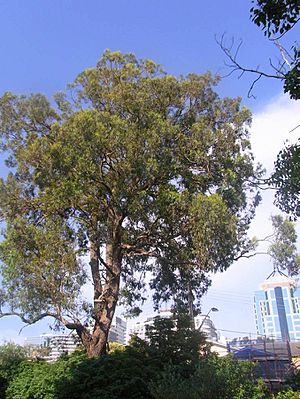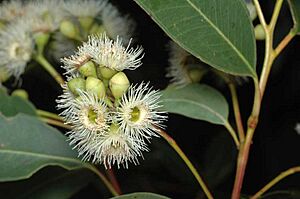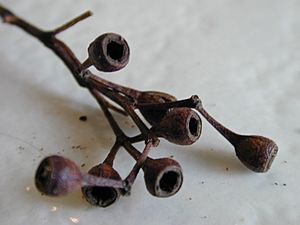Grey ironbark facts for kids
Quick facts for kids Grey ironbark |
|
|---|---|
 |
|
| habit in Chatswood | |
| Scientific classification | |
| Genus: |
Eucalyptus
|
| Species: |
paniculata
|
The Grey Ironbark (scientific name: Eucalyptus paniculata) is a type of tree. It is found only in New South Wales, Australia. This means it is endemic to that area.
This tree is easy to spot because of its special bark. It has dark, rough bark that looks like iron on its trunk and branches. Its leaves are long and narrow, and its flowers are white. The tree also produces small, woody fruits.
Contents
What the Grey Ironbark Looks Like
The Grey Ironbark is a tall tree. It usually grows to be about 30 to 50 meters (about 100 to 165 feet) tall. It has grey, black, or brownish bark that is deeply grooved, like wrinkles, on its trunk and branches. This rough bark is called ironbark.
Leaves
When the tree is young, its leaves are shaped like an egg or a spear. They are lighter green on the underside. These young leaves are about 3.5 to 7 centimeters (1.4 to 2.8 inches) long.
Adult leaves are shiny green and also lighter on the underside. They are shaped like a spear or slightly curved. These leaves are longer, about 5 to 18 centimeters (2 to 7 inches) long. Each leaf has a stalk called a petiole.
Flowers and Fruit
The flowers of the Grey Ironbark are white. They usually grow in groups of seven on a branched stalk. The flower buds are oval or diamond-shaped.
This tree can flower in most months of the year. After flowering, it produces woody fruits. These fruits are shaped like a cone, a half-sphere, or a cup. They are about 4 to 8 millimeters (0.16 to 0.31 inches) long and wide.
How the Grey Ironbark Got its Name
The Grey Ironbark was first officially described in 1797. A scientist named James Edward Smith wrote about it. He got the tree samples from Port Jackson in New South Wales.
The scientific name paniculata comes from a Latin word. It means "paniculate," which describes how the flowers are arranged on the tree.
Where the Grey Ironbark Grows
The Grey Ironbark grows in coastal areas of New South Wales. It likes places that get a lot of rain. You can find it from Bermagui up to Bulahdelah.
This tree used to be very common in the inner western suburbs of Sydney. Today, you can still see a very old Grey Ironbark tree in the inner-city suburb of Glebe, near St. Johns church.
Uses of Grey Ironbark Timber
The wood from the Grey Ironbark tree is very useful. People who work with forests value it highly because it is strong and lasts a long time.
Timber Qualities
The timber is very hard and dense. It weighs about 1120 kilograms per cubic meter. The inner part of the wood, called the heartwood, is red-brown or dark brown.
What the Timber is Used For
Because it is so strong, Grey Ironbark timber is used for many things. It is used to make:
- Railway sleepers (the wooden beams under train tracks)
- Heavy construction projects
- Poles and cross-arms (for power lines, for example)
- Even archery bows!
It can be a bit tricky to work with this timber because it's so hard. It also dries slowly, so it needs to be handled carefully to avoid cracks. Luckily, a type of insect called the lyctus borer, which can damage wood, does not usually bother Grey Ironbark timber.
Images for kids
-
A remnant tree at St. Johns Church, Glebe
See also
 In Spanish: Eucalipto corteza gris hierro para niños
In Spanish: Eucalipto corteza gris hierro para niños








